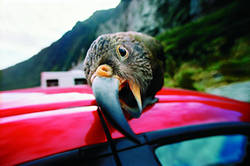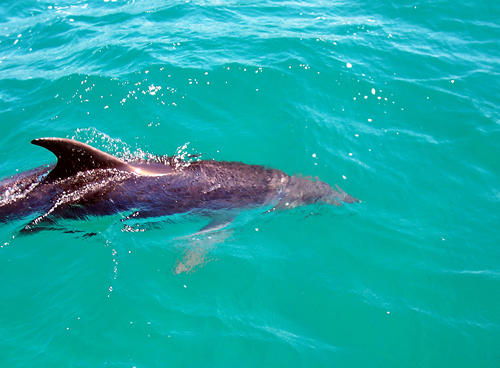|
No
Snakes Here, Mate! Just Crazy Keas and Bubbling Mud
 Beaches
of glistening sand with not a footprint in sight, primeval forests
where the trees are a thousand years old, cauldrons of bubbling
mud in a geothermal wonderland, and green
pastures where cattle and sheep graze beneath snowy mountain ranges
- the diversity of the New Zealand landscape astonishes visitors. Beaches
of glistening sand with not a footprint in sight, primeval forests
where the trees are a thousand years old, cauldrons of bubbling
mud in a geothermal wonderland, and green
pastures where cattle and sheep graze beneath snowy mountain ranges
- the diversity of the New Zealand landscape astonishes visitors.
Geologically,
the land is remarkably young, with active volcanoes
in the North Island, but its flora and fauna are of an antiquity
found nowhere else in the world.
Some
of its plants are so primitive they are described as living fossils.
The
giant lizard known as the tuatara is the worldís only living relative
of the dinosaurs that roamed the earth 220 million years ago. The
largest of these scaly beasts is 60cm long and 100 years old. Tuatara
can be seen in sanctuaries and on offshore islands.
Of
a similarly venerable lineage is the weta, a common garden insect
the size of a mouse with spiny legs and giant jaws.
 The
kiwi, New Zealandís national symbol, a nocturnal, flightless bird
with nostrils at the tip of its beak, is also a relic of the time,
70 million years ago, when the fragment of land which became New
Zealand broke away from the southern supercontinent of Gondwanaland. The
kiwi, New Zealandís national symbol, a nocturnal, flightless bird
with nostrils at the tip of its beak, is also a relic of the time,
70 million years ago, when the fragment of land which became New
Zealand broke away from the southern supercontinent of Gondwanaland.
With
no native mammals (except one species of short-tailed bat) and no
marsupials, New Zealandís birds, reptiles and insects were left
alone to pursue their curious lives and evolve unmolested by predators.
Like so many native birds, the kiwi is endemic to New Zealandís
islands but its survival in the wild is tenuous, with predators
such as feral cats and stoats now impacting dramatically on numbers.
The kiwiís habitat has also been reduced.
In
the North Island only pockets of the original lush rain forests
remain because the timber was sought after for shipsí masts, boat
building and houses, and vast tracts were cleared for pasture.
Walking
through these precious remnants is an awe-inspiring experience,
like being in a leafy, green cathedral, so high is the canopy. The
understorey is a mass of ferns, tree ferns, vines, and palms, and
delicate mosses and lichens carpet the forest floor.
The
tallest tree, known by its Maori name kahikatea, reaches 60m and
is a type of conifer called podocarp. But the most famous tree is
the kauri, one of the largest found anywhere in the world. A specimen
in the North Islandís Waipoua forest has a girth of 17.2m, stands
51.2m tall and is more than 2100 years old. This tree is easily
accessible to visitors and is so revered it has its own name, Tane
Mahuta (God of the forest).
Sanctuary
Near the City
Closer
to Auckland, the countryís most populous
city, visitors can take a boat trip to the sanctuary on Tiritiri
Matangi island where volunteers have spent years replanting the
native vegetation and where several species of endangered native
birds have been successfully established.
These
include the takahe, the large, bright-blue flightless rail that
was thought to be extinct until it was rediscovered in remote Fiordland
in 1948, and the kokako, or blue wattled crow, whose haunting call
is only rarely heard in mainland forests.
The
mountainous areas of the North and much of the South Island are
still dominated by beech forest and it is this spectacular landscape
that attracts the more adventuresome visitor for hiking, rock climbing
and skiing. In the north, three mountains - Ruapehu, Tongariro and
Ngauruhoe - rise magnificently from the central volcanic plateau.
Above
the tree-line, their rocky slopes offer bounties of yellow ranunculus,
white mountain daisy and the tiny sweet-scented pimelea amongst
the tawny tussocks (alpine grass).
In
the South Island the Southern Alps form a mountainous spine ending
in the countryís least explored domain, that of Fiordland. The bleak
slopes host an extraordinary 600-odd plant species, 93 per cent
of which are unique to New Zealand.
 Visitors
will also inevitably encounter one of the South Island mountainsí
clowns, a wily parrot called the kea whose antics can be both alarming
and amusing. Visitors
will also inevitably encounter one of the South Island mountainsí
clowns, a wily parrot called the kea whose antics can be both alarming
and amusing.
Kea
appear unafraid of humans and will steal objects from cars, and
damage windscreen wipers and mirrors. Competition for food in their
subalpine habitat has led them to become scavengers and, more disastrously,
to attack sheep and, until 1970, they were culled. Now, as with
all native birds, it is an offence to kill them.
Predators
Still a Pest
While
the lack of snakes and venomous insects makes New Zealandís wilderness
areas a safe environment in which to walk, they are also home to
wild goats, deer, rats, stoats, weasels and the ubiquitous Australian
possum. These introduced animals were harmless in their original
habitats, but have become noxious pests in New Zealand.
They
destroy native trees and other plants by eating new shoots and leaves,
compete with native birds for food, and in the case of the kiwi,
kill 95 per cent of kiwi chicks before they are six months old.
They also eat the eggs and young of other native birds.
Possums
are the worst - their population is estimated to be about 70 million
despite intensive eradication programmes and the presence of their
formidable foe - the car.
Sea Life to See
 For
visitors interested in marine life, New Zealandís extensive coastline
is a rich environment. A pod
of sperm whales lives off the east coast of the South Island
near the small town of Kaikoura. For
visitors interested in marine life, New Zealandís extensive coastline
is a rich environment. A pod
of sperm whales lives off the east coast of the South Island
near the small town of Kaikoura.
Three-hour
boat trips take tourists to view the giant creatures, which can
be seen all year round. Other species, orca and the odd humpback,
also make occasional appearances.
Kaikouraís
rocky shore has a resident colony of fur seals and viewing platforms
enable visitors to watch them cavorting in the sea.
Dolphins
are seen all around New Zealandís waters, with the rare Hectorís
dolphin, endemic to New Zealand, best seen in Akaroa, a small settlement
near Christchurch in the South Island.
Eyes
on the Geysers
Of
all New Zealandís natural splendours, nothing surpasses the geothermal
wonderland at Rotorua in the North Islandís
central volcanic plateau.
Geysers
of mineral-rich boiling water spout plumes metres high, mud
pools plop in lazy circles, and steam rises from the shores of the
areaís numerous lakes.
Whakarewarewa
is the traditional focal point for tourists and is also the sacred
ground of the Ngatiwhakaue tribe of the indigenous Maori people.
The
Waimangu valley is another spectacular
site and is significant as the only unmodified geyser field. Use
of the thermal energy for electricity generation has lead to a decrease
in activity, but much of its dramatic intensity remains.
Summer
Sight
Visitors
to New Zealand during summer will see New Zealandís Christmas tree
- the pohutukawa, fringing northern beaches and clinging to seaside
cliffs. The trees have masses of stunning crimson flowers and have
cultural significance for Maori.
At
Spirits Bay in Northland, Cape
Reinga (the far north of the North Island), an old pohutukawa
is said to be where spirits leave on their journey through the underworld
after death. One in Kawhia Harbour is said to be the tree the Tainui
canoe tied up to after its voyage across the Pacific 1000 years
ago.
For
New Zealanders today, the trees are synonymous with long, summer
days (November-February) - of sun, surf and sand.
They
provide wonderful natural shade in the hot sun and youíll always
find someone picnicking under the umbrella shade of a pohutukawa
or tucking into that favourite of kiwi takeaways (takeouts), fish
and chips.
-
Copyright 1999-2004 Tourism New Zealand
- Kiwi and Kea Photos courtesy of Tourism New Zealand
|



